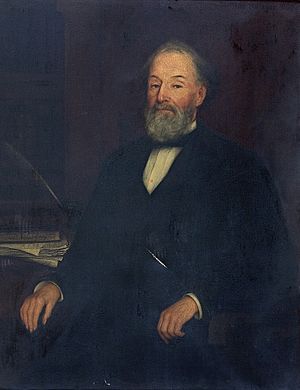Rowland G. Hazard facts for kids
Quick facts for kids
Rowland G. Hazard
|
|
|---|---|

Portrait of Hazard by Jean Paul Selinger, 1880
|
|
| Member of the Rhode Island House of Representatives | |
| In office 1880–1880 |
|
| In office 1854–1855 |
|
| In office 1851–1852 |
|
| Member of the Rhode Island State Senate | |
| In office 1866–1867 |
|
| Personal details | |
| Born |
Rowland Gibson Hazard
October 9, 1801 South Kingstown, Rhode Island, U.S. |
| Died | June 24, 1888 (aged 86) Peace Dale, Rhode Island, U.S. |
| Political party | Republican |
| Spouses |
Caroline Newbold
(m. 1828; |
| Relations | Thomas Robinson Hazard (brother) Caroline Hazard (granddaughter) |
| Children | Rowland Gibson Hazard II John Newbold Hazard |
| Parents | Rowland Hazard Mary Peace Hazard |
| Signature | |
Rowland Gibson Hazard (born October 9, 1801 – died June 24, 1888) was an important American businessman, politician, and social reformer. He was known for his work in the textile industry, his efforts to help free people, and his time serving in government.
Contents
Early Life and Education
Rowland Gibson Hazard was born on October 9, 1801, in South Kingstown, Rhode Island. He was one of nine children. His parents were Mary Peace and Rowland Hazard. His father started the Peace Dale Manufacturing Company in Peace Dale, Rhode Island, in 1802.
Rowland came from an old Quaker family in New England. The Quakers are a religious group known for their peaceful beliefs. He grew up in Bristol, Pennsylvania, living with his grandparents. He went to a Quaker boarding school in Burlington, New Jersey. There, he became very interested in mathematics.
A Career in Business
In 1819, Rowland returned to Rhode Island to work with his older brother, Isaac. They managed the Peace Dale Manufacturing Company together. This company made textiles, which are fabrics like cloth.
Later, their third brother, Joseph, joined the business. The company was then called "R.G. Hazard & Co." Rowland's job included selling their products to customers in the southern United States.
In 1843, Hazard bought another textile mill in a village now called Carolina, Rhode Island. He named the mill and the village after his wife, Caroline. The Carolina Mills Company stayed in his family for many years.
After a fire destroyed one of their mill buildings in 1845, the brothers rebuilt. They added new facilities and improved their hydropower systems. In 1848, the business officially became the Peace Dale Manufacturing Company. They started making higher-quality wool products instead of cheaper fabrics.
Helping Others: Abolitionist Work
From 1833 to 1842, Rowland Hazard spent winters in New Orleans for business. He sold various goods, including fabrics used by enslaved people.
In 1841, while in New Orleans, Hazard learned that a free African-American man from Newport, Rhode Island, was being held as if he were an escaped slave. Hazard investigated and found that many free African-Americans were wrongly held captive.
He worked with a lawyer named Jacob Barker to help these people. Together, they helped nearly 100 people gain their freedom. This action even led to charges against some public officials who were involved in the illegal detentions.
Hazard's involvement in abolitionism (the movement to end slavery) and the Republican Party caused his company to lose business in the southern states. This encouraged the Peace Dale mills to focus even more on making high-quality woolens.
Public Service and Politics
Rowland Hazard was also active in politics. He served three one-year terms in the Rhode Island House of Representatives. He was elected in 1851, 1854, and 1880. He also served as a state senator from 1866 to 1867.
In 1856, he was a delegate for Rhode Island at the very first meeting of the Republican Party. Four years later, he was also a delegate at the 1860 Republican National Convention.
In 1851, Hazard proposed a bill in Rhode Island. It suggested that railroad companies should provide fair benefits to the public. In 1854, he spoke out against a railroad company for charging unfair prices. The company then refused to let him ride their trains. This event helped lead to the Interstate Commerce Act of 1887, a law that regulated railroads.
Later Years and Contributions
Hazard retired from the textile business in 1866. He invested in the Union Pacific Railroad. When the railroad faced financial problems, Hazard spent a lot of time helping to fix its money issues.
He was also a talented writer. He wrote many books and essays about philosophy, economics, and politics.
Rowland Hazard was a generous person. He supported schools and churches in South Kingstown. He also donated $40,000 to Brown University to create a professorship in physics. Brown University honored him with degrees in 1845 and 1869.
Family Life
In 1828, Rowland Hazard married Caroline Newbold. They had two sons:
- Rowland Gibson Hazard II (1829–1898): He later owned the Solvay Process Company.
- John Newbold Hazard (1836–1900): He built the Narragansett Pier Railroad.
Rowland Gibson Hazard passed away in Peace Dale on June 24, 1888. He was buried in Oak Dell Cemetery in South Kingstown.
His Grandchildren
Through his son Rowland, he had several grandchildren, including:
- Caroline Hazard (1856–1945): She became an educator and author. She was also the fifth president of Wellesley College.
- Frederick Rowland Hazard (1858–1917): He was an executive at the Solvay Process Company. He is known for hiring architect Joseph Lyman Silsbee to build his home, Upland Farm.
- Irving Fisher (1867–1947): An important economist and inventor, who married Rowland's granddaughter Margaret.

